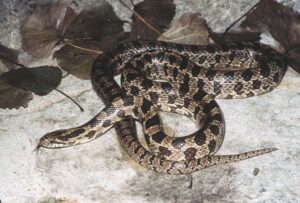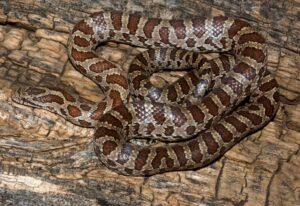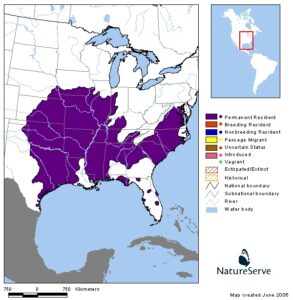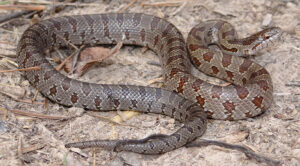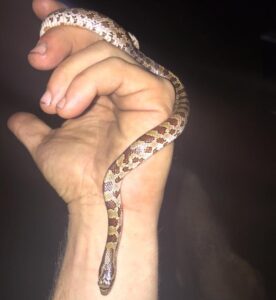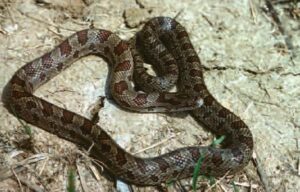The prairie kingsnake, also known as the yellow-bellied kingsnake, is a medium-sized fossorial snake. They are typically active from April through November, being nocturnal in summer and active in the mornings and early evenings in spring and autumn. Its common name can be attributed to its original habitat of prairies.
Scientific Classifications
- Suborder:Serpentes
- Family:Colubridae
- Genus:Lampropeltis
- Species:L. calligaster
Conservation Status
Description
Size
The snake can attain a length of 30-40 in (76-102 cm).
Color and Appearance
It is gray or light brown in color, with dark brown, dark gray, or reddish brown blotches running down the length of its body. Some individuals have faded patterns that make their bodies appear almost solid brown. The belly is tan or yellowish with blocky brown patterns. The top of the rounded head has a backward-pointing U- or V-shaped marking.
The juveniles usually have a dorsal brown stripe along the length of their bodies. There are two black spots behind their head and smaller black spots on both sides along the length of the stripe.
Are They Dangerous to Humans
Prairie kingsnakes are non-venomous and typically docile. If harassed, they shake their tails, which can make a sound similar to rattlesnakes in dry leaf litter. They are averse to biting but often excrete a foul-smelling musk if handled. Threatening also causes them to flatten and appear to have white spots.
Prairie Kingsnakes at a Glance
Distribution
The snake is primarily found in the southeastern and midwestern United States. Additionally, its range extends west from southeast Nebraska to eastern Texas.
Habitat
They prefer open grasslands with loose, dry soil, especially at the edges of a forested area that is not far from a permanent water source. Often hiding underneath logs, in abandoned structures, debris, and tree trunks, the colubrids are rarely seen due to their secretive nature.
Lifespan
The prairie kingsnake lives for around 10 years in the wild and a maximum of 24 years in captivity.
Predators
They have many predators, including striped skunks, raccoons, Virginia opossums, and other kingsnakes.
Diet
They primarily eat rodents but can also have frogs, lizards, and, occasionally, other snakes.
Reproduction
Oviparous (lays eggs that hatch outside the body)
Mating occurs in early spring, soon after they emerge from brumation. The eggs are laid from June through July, with the clutch size varying from 6-17 eggs.
Care Sheet
Size of the Enclosure: An elongated vivarium with a length of at least 34 inches should be used to keep the snake. The width of the enclosure should be at least a third of the snake’s size.
Temperature: The cool end temperature should be 70°F-75°F, while that of the basking area should be 84°F-88°F. It should never fall below 64°F.
Humidity: The pet does best in humidity levels of 40%-55%. A water bowl large enough for the snake to soak itself should be included in the cool end of the cage.
Substrate: Cypress mulch and aspen shavings are ideal choices for the substrate.
Feeding: They can be fed thawed mice of the same size or slightly bigger than the snake’s girth every 10-14 days and 5-6 days for adults and babies, respectively.
Source
reptilesmagazine.com, static.wikia.nocookie.net, tn.gov, illinois.gov, scontent.fccu4-2.fna.fbcdn.net, wildlifeillinois.org

